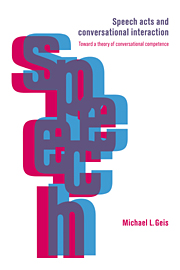3 - The structure of communicative interactions
Published online by Cambridge University Press: 16 October 2009
Summary
Introduction
In this chapter, I turn to consider how speech act theory can be modified so that it can do for the analysis of conversation what traditional speech act theory did for the analysis of individual utterances. The goal of traditional speech act theory was to account for our ability to recognize the illocutionary point of a speaker in uttering any sentence. It was assumed that we recognize the point of an utterance by recognizing the action that the speaker means to be performing. Thus, according to speech act theorists, if you and I are dining together and you say, Can you pass the salt?, I will recognize that you mean for me to pass you the salt in virtue of recognizing that you are requesting me to pass the salt. How, then, do we recognize what speech act a speaker means to be performing?
According to Searle, a given utterance act is an action of a particular type if it meets the conditions on that type of act. Thus, for instance, if an utterance is produced by a speaker that (a) predicates a future action of the speaker (Searle's propositional content condition) when (b) it is evident that the speaker is able to perform this action (a Searlean preparatory condition) and (c) the addressee has made evident a desire that the speaker perform this action (a Searlean preparatory condition), then the addressee is entitled to assume that the speaker means to be making a commitment to the addressee to perform this action (Searle's essential condition and the illocutionary point of the act) and that the speaker will in fact perform the action (Searle's sincerity condition).
- Type
- Chapter
- Information
- Speech Acts and Conversational Interaction , pp. 54 - 96Publisher: Cambridge University PressPrint publication year: 1995



